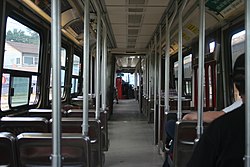| CLRV | |
|---|---|
 A 506 Carlton CLRV car crosses the Main Street Bridge in 2008. | |
 Interior of the CLRV | |
| In service | 1979–2019 |
| Manufacturer | |
| Constructed | 1977–1981[1] |
| Entered service | September 30, 1979 |
| Number built | 196 |
| Number in service | 0[1] |
| Number preserved | 11 in Canada, 4 in United States |
| Number scrapped | ~190 |
| Successor | Flexity Outlook |
| Fleet numbers |
|
| Capacity | 42–46 seated,[a] 74 at peak with standees[1] |
| Operators | Toronto Transit Commission (former, all retired with a few cars to be restored for special occasions), Halton County Radial Railway (3 cars as work museum artifacts) |
| Lines served | Toronto streetcar system |
| Specifications | |
| Car length | 15.226 m (49 ft 11+7⁄16 in)[2] |
| Width |
|
| Height | 3.625 m (11 ft 10+11⁄16 in)[2] |
| Floor height | 1.125 m (3 ft 8+5⁄16 in)[2] |
| Platform height | curb height or level with rail head |
| Entry | 4 steps (3 risers inside plus step up from outside) |
| Doors | 2 (1 dual bi-fold front door; 2 paired double leaf rear doorways) |
| Maximum speed | 80 km/h (49.7 mph)[3] |
| Weight | 22,685 kg (50,011 lb 14 oz) |
| Power output | 2 x 136 kW (182 hp) continuous |
| Acceleration | 1.47 m/s2 (4.8 ft/s2) or 5.3 km/(h⋅s); 3.3 mph/s |
| Deceleration |
|
| Electric system(s) | 600 V DC overhead |
| Current collector(s) | Trolley pole |
| Minimum turning radius | 36 ft (10.973 m) |
| Braking system(s) | Air (Westinghouse Air Brake Company) |
| Track gauge | 4 ft 10+7⁄8 in (1,495 mm) – TTC gauge |
| ALRV | |
|---|---|
 A Queen car pauses at Spadina Avenue | |
 Interior of the ALRV | |
| In service | 1988–2019 |
| Manufacturer | |
| Constructed |
|
| Entered service | January 19, 1988 |
| Number built | 52 and 1 prototype |
| Number in service | 0 |
| Number preserved | 2 |
| Number scrapped | 50 and 1 prototype |
| Successor | Flexity Outlook |
| Fleet numbers |
|
| Capacity | 61 seated, 108 at peak with standees[4] |
| Operators | Toronto Transit Commission (former, all retired; 1 car awaiting restoration), HCRR (1 car awaiting restoration) |
| Lines served | Toronto streetcar system |
| Specifications | |
| Car length | 23.164 m (75 ft 11+15⁄16 in)[5] |
| Width |
|
| Height | 3.626 m (11 ft 10+3⁄4 in) to roof; roof equipment additional[5] |
| Floor height | 1.125 m (3 ft 8+1⁄4 in)[2] |
| Platform height | curb height or level with rail head |
| Entry | 4 steps (3 risers inside plus step up from outside) |
| Doors | 3 |
| Articulated sections | 1 section with 2 articulations |
| Maximum speed | 80 km/h (49.7 mph)[3] |
| Weight | 36,745 kg (81,009 lb) |
| Power output | 4 × 65 kW (87 hp) continuous |
| Acceleration | 1.2 m/s2 (3.9 ft/s2) or 4.3 km/(h⋅s); 2.7 mph/s |
| Deceleration | 1.6 m/s2 (5.2 ft/s2) or 5.8 km/(h⋅s); 3.6 mph/s Emergency: 3.13 m/s2 (10.3 ft/s2) or 11.3 km/(h⋅s); 7.0 mph/s |
| Electric system(s) | 600 V DC overhead |
| Current collector(s) | Trolley pole |
| Minimum turning radius | 36 ft (10.973 m) |
| Braking system(s) | Air (Westinghouse Air Brake Company) |
| Track gauge | 4 ft 10+7⁄8 in (1,495 mm) – TTC gauge |
The Canadian Light Rail Vehicle (CLRV) and Articulated Light Rail Vehicle (ALRV) were types of streetcars used by the Toronto Transit Commission (TTC) from the late 1970s until the late 2010s. They were built following the TTC's decision to retain streetcar services in the 1970s, replacing the existing PCC streetcar fleet.
Two variants were produced: the standard single-module CLRV (built between 1977 and 1981) and the longer articulated double-module ALRV (built between 1987 and 1989). The ALRVs were officially retired from regular TTC service on September 2, 2019, with the CLRVs officially retired on December 29, 2019.[6][7][8] Both were replaced by the Flexity Outlook, a low-floor streetcar first introduced in 2014.
- ^ a b c "Service Summary – November 24, 2019 to January 4, 2020" (PDF). Toronto Transit Commission. November 23, 2019. Retrieved November 23, 2019.
- ^ a b c d e Cite error: The named reference
TT-CLRVwas invoked but never defined (see the help page). - ^ a b TTC – The Coupler – Wheels of Progress Archived January 28, 2018, at the Wayback Machine. Toronto Transit Commission. Retrieved on March 16, 2015.
- ^ a b c Cite error: The named reference
TTC-Srv-Sum-2019-09-01was invoked but never defined (see the help page). - ^ a b c Cite error: The named reference
TT-ALRVwas invoked but never defined (see the help page). - ^ "Chief Executive Officer's Report – May 2019 Update" (PDF). Toronto Transit Commission. May 8, 2019. p. 43. Archived (PDF) from the original on May 3, 2019. Retrieved May 3, 2019.
- ^ Bañares, Ilya (August 28, 2019). "Monday is your last chance to ride the TTC's old, articulated streetcars". Toronto Star. Retrieved August 30, 2019.
- ^ "TTC's legacy CLRV streetcars reach the end of the line on Dec 29". TTC. November 21, 2019. Archived from the original on November 22, 2019. Retrieved November 24, 2019.
Cite error: There are <ref group=lower-alpha> tags or {{efn}} templates on this page, but the references will not show without a {{reflist|group=lower-alpha}} template or {{notelist}} template (see the help page).